This is a guest post by Jennifer Zimmerman about how she set up a Montessori and Waldorf inspired space for her kids to learn and play.
When my son Owen was approaching preschool age, we moved into a new home. This motivated me to really think about his new bedroom and how I wanted him to use it. I also thought a lot about his future schooling and which educational philosophies would be a good match for his personality and needs. I looked into both Montessori and Waldorf education. I liked different things about both philosophies. I liked how Montessori encouraged self-help skills, independence and allowed the child to choose learning materials that fit their abilities and advance at their own pace. Yet, I also felt myself attracted to how Waldorf focused on the arts, encouraged pretend play and immersed children into a magical fantasy world. I favored Montessori for Owen, but I still wanted to incorporate a few things from Waldorf. I set out to create a fun and playful environment that had many opportunities for self-directed learning and exploration.
I loved the Montessori reading nooks, and so I created one by using a short and wide bookshelf to partition off a small area of his room. I hung a reading lamp on the wall and placed cozy pillows and stuffed animals near his rocking chair inside the nook. I placed his books on the bookshelf in easy reach so he could choose which ones to pull out and read. In this photo you can see his partitioned off nook. Just behind the shelf is where his cozy reading spot was:

In another area of the room I hung a mirror close to the floor at my son’s level. The low hanging mirror is a common Montessori item, but this is also where some Waldorf influence came in. I hung some dress up clothes on hooks near the mirror, as well as some colorful play silks for pretend play. Play silks are an open ended toy which Waldorf really encourages.

Open ended toys are toys that are gender neutral and do not have a specific purpose. Their purpose is up to the child to imagine. Play silks are square or rectangular pieces of real silk that usually have been dyed different colors. A play silk can be tied on the body as a skirt, a hat, a cape, wings, or a doll sling. They can be used as water, land, or sky with small toys, as a doll blanket, or simply waved around in the air during active play. Another example of an open ended toy is a push cart. The cart can be used by babies learning to walk, by toddlers transporting toys, as a stroller for dolls or stuffed animals, as a dump truck, or many other things according to what the child wants to imagine that day. Waldorf toys are quite spendy, so if you are on a budget like me then you must get creative about obtaining them. Waldorf-like toys can be purchased at thrift stores or homemade. There are many websites that give directions on how to make Waldorf toys if you are crafty. I bought the play silks as blanks for around five dollars each and then dyed them myself. I bought a push cart at Ikea for just under twenty dollars. This multipurpose toy, which can be used for many years, was well worth the price.
Next, I placed some Montessori-inspired educational materials on low shelves. These shelves should be short enough for children to reach, and wide enough to hold quite a few materials. The materials are objects and toys that allow children to practice life skills. Things like stringing beads and shape puzzles are placed in bowls or on trays on the shelves. There are many websites that show how to create these materials yourself. This concept melded very well with Waldorf’s idea of having natural objects around to be used as open ended play things. I found many real wood bowls and plates at thrift stores, some even shaped like tree leaves, and filled them with objects from nature such as pine cones, rocks, and nuts. Owen had a small table and chair that he could bring his materials over to play with them.
One area where Waldorf and Montessori are in complete agreement is the play kitchen. A play kitchen is a place that is ripe for pretend play for any preschooler, and also teaches important life skills to satisfy the Montessori side of things. Along with Owen’s play kitchen, we also found him a small play hutch made out of real wood at a thrift store. The hutch has real glass doors and contains real ceramic dishes, real metal pots and pans, cookware and silverware from Ikea. Learning to handle fragile items at a young age is an important aspect of Montessori education, and Waldorf stresses using natural materials for everything that comes into contact with the child. If a dish breaks, cleaning it up also becomes a learning experience that the child can be engaged in. They can use their child sized broom and dust pan to help clean it up. Owen not only plays with real glass and ceramic kitchen items, he also eats and drinks from them. As a result, he learned about these materials early in life and is very careful with them. In fact, I accidentally break more dishes then he does.

In Owen’s closet I placed a large shelf that holds his folded clothing. There is also a bar at his height with some of his clothes hung on it. This is another Montessori philosophy. Children are encouraged to choose their own clothing from a young age. Having the clothes out on shelves instead of stuffed into drawers makes it much easier for little hands to find what they need without making a big mess. Dressing oneself is another life skill that Montessori teaches. Waldorf encourages that clothing be made out of natural materials such as cotton or wool, and they discourage any commercial or fictional characters on clothing. This is one of those somewhat odd things about Waldorf (there are many!) but one that I personally try to live by.
 What we didn’t have room for in Owen’s room was an art station. Art, music and dancing are a very important part of a Waldorf education. We stored Owen’s art and music supplies in a tall shelf with bins. The art bin could easily be taken out and carried to the kitchen where Owen was encouraged to paint, color and draw. Owen preferred abstract paintings and I learned that if I gave him three complementary colors he would produce some pretty cool looking art work.
What we didn’t have room for in Owen’s room was an art station. Art, music and dancing are a very important part of a Waldorf education. We stored Owen’s art and music supplies in a tall shelf with bins. The art bin could easily be taken out and carried to the kitchen where Owen was encouraged to paint, color and draw. Owen preferred abstract paintings and I learned that if I gave him three complementary colors he would produce some pretty cool looking art work.
Owen is six years old now, and he has been joined by his little sister Isla who just turned 16 months. We just recently moved again and I now face the task of setting up a bedroom for each of them, and a small play area that they can play in together. Thanks to their Montessori and Waldorf inspired toys, it is not hard to create a play room that a six-year old boy and 16-month old girl can play in together. They both love their play kitchen. While Owen ties play silks around his neck as capes, Isla uses them to wrap up her dolls. They both push their dolls and stuffed animals around in their cart, and Owen even gives Isla a ride in it every so often. They do art work together and Owen reads books to his little sister. Owen ended up attending a traditional school as he didn’t make it through the lottery system to gain entrance to the Montessori public school in our city. Waldorf was never an option for him, mostly because it is private and very expensive, but also because some aspects of their philosophy do not mesh with his personality or our personal beliefs. However, I think what we did take from both systems was very beneficial for him, and will also be beneficial for Isla as she grows.
—
Jennifer lives with her family in St. Paul, MN. You can read more about Owen and Isla on her blog, Kinder Tales.
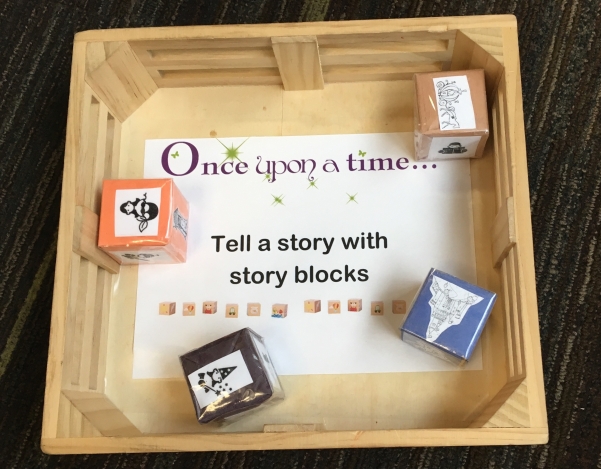 We celebrated Picture Book Month with an Enchanted Forest theme. Kids could dress up as fairy tale characters or use the stuffed animals to tell their own version of familiar stories. The story cubes could spark a creative retelling that mixes up all sorts of fairy tale elements. I made these myself by covering some wooden blocks with construction paper and tape, but you can also buy story cubes or story sticks aimed at preschoolers to encourage storytelling.
We celebrated Picture Book Month with an Enchanted Forest theme. Kids could dress up as fairy tale characters or use the stuffed animals to tell their own version of familiar stories. The story cubes could spark a creative retelling that mixes up all sorts of fairy tale elements. I made these myself by covering some wooden blocks with construction paper and tape, but you can also buy story cubes or story sticks aimed at preschoolers to encourage storytelling.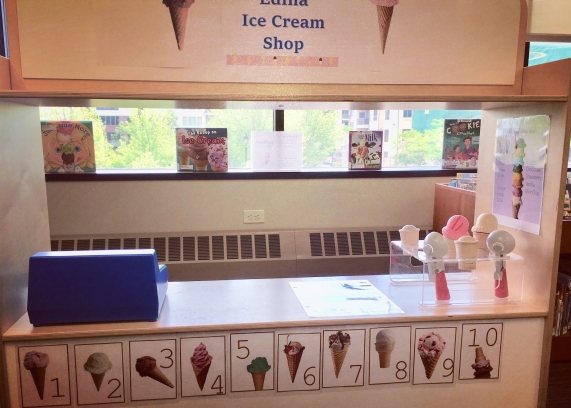 In the grocery store, the ice cream shop, and other community based play spaces, kids can imagine themselves in various roles. They can take turns being proprietor or a customer, seeing the interactions from different roles and developing empathy for experiences outside of their own.
In the grocery store, the ice cream shop, and other community based play spaces, kids can imagine themselves in various roles. They can take turns being proprietor or a customer, seeing the interactions from different roles and developing empathy for experiences outside of their own.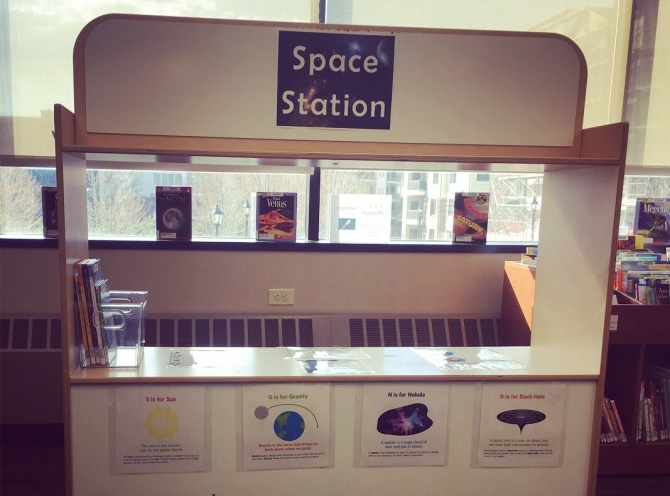 In the Fix It Shop, we named the tools. In the Sense Lab, we encouraged the use of descriptive language as kids explored the world with their senses. Our Space Station offered various science words. Don’t underestimate kids’ willingness to learn complex vocabulary if they are interested in the topic!
In the Fix It Shop, we named the tools. In the Sense Lab, we encouraged the use of descriptive language as kids explored the world with their senses. Our Space Station offered various science words. Don’t underestimate kids’ willingness to learn complex vocabulary if they are interested in the topic!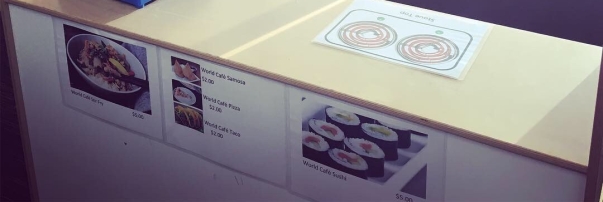 In the community based play spaces (World Café, Ice Cream Shop, etc), the menus and other signage are examples of the way that we interact with printed words as we life our lives. Understanding just how much we rely on printed language is an important part of learning to read.
In the community based play spaces (World Café, Ice Cream Shop, etc), the menus and other signage are examples of the way that we interact with printed words as we life our lives. Understanding just how much we rely on printed language is an important part of learning to read.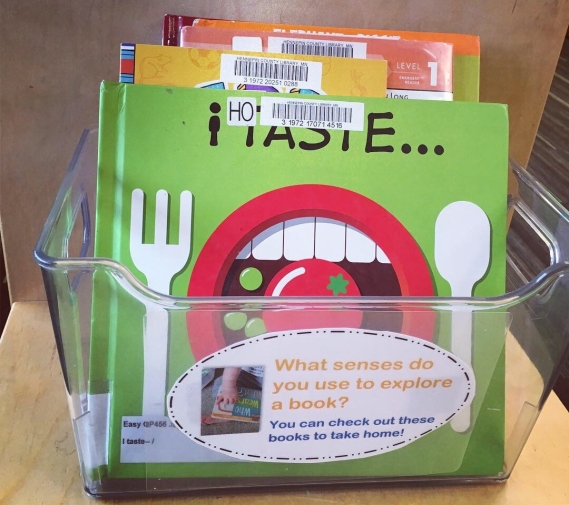 Kids and caregivers are always encouraged to learn more about the topics with books. Learning to read is hard work, and if kids are interested in the topics they are reading about, they be much more motivated.
Kids and caregivers are always encouraged to learn more about the topics with books. Learning to read is hard work, and if kids are interested in the topics they are reading about, they be much more motivated. Exploring shapes and sorting objects based on likes and differences is a first step to letter knowledge. Our grocery store featured pictures of letters made out of food, and the Sense Lab encouraged sorting objects based on how they feel.
Exploring shapes and sorting objects based on likes and differences is a first step to letter knowledge. Our grocery store featured pictures of letters made out of food, and the Sense Lab encouraged sorting objects based on how they feel.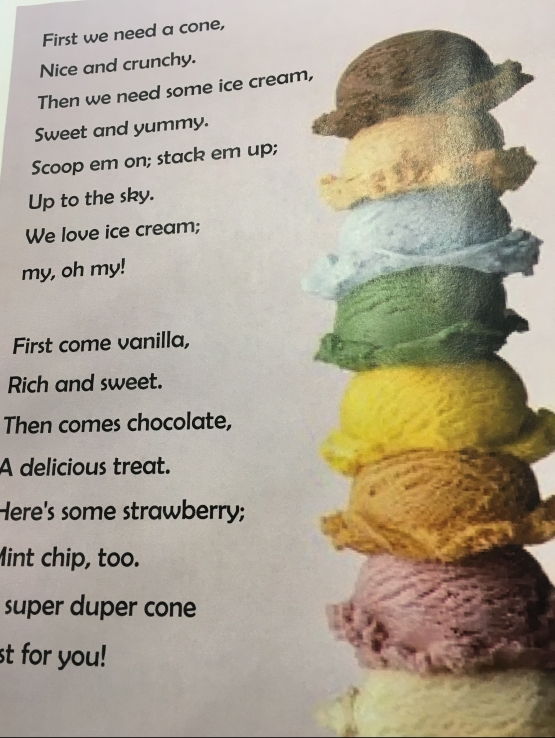 Singing songs and chanting rhymes help kids hear the sounds of words more clearly than in regular speech. We included the words to a rhyme in our Ice Cream Shop and our Space Station to add an opportunity to build phonological awareness while at play.
Singing songs and chanting rhymes help kids hear the sounds of words more clearly than in regular speech. We included the words to a rhyme in our Ice Cream Shop and our Space Station to add an opportunity to build phonological awareness while at play.



























